
Jennifer Poh , Régis Vaillancourt , Diane Lamarre , Josephine Oyella
Pharmaciens sans frontières (also known as Pharmacists Without Borders—Canada or PSF-Canada) has an ongoing collaboration with St Mary’s Lacor Hospital (Lacor Hospital) in the Gulu district of northern Uganda. Founded by a group of Comboni missionaries in 1959 and developed by 2 physicians, Dr Lucille Teasdale and Dr Piero Corti, Lacor Hospital has grown from a small 30-bed institution to its current capacity of 483 beds and hosts an average of 600 inpatients and 500 outpatient visits each day. In addition to the main hospital compound, Lacor Hospital owns and operates 3 peripheral health centres, each with a 24-bed capacity. Because of its size and reputation as the best tertiary care hospital in Uganda, Lacor Hospital serves as a training ground for various health care professionals: it is a teaching site for the Gulu University Faculty of Medicine, as well as for the Lacor School of Nursing and the Lacor School of Laboratory Technology.
One of the challenges identified by the executive team at Lacor Hospital has been the need for the hospital’s Department of Pharmacy to establish optimal strategies for logistic support and technical assistance with regard to medication management. This objective aligns with the call for optimizing patient safety through the judicious, safe, efficacious, appropriate, and cost-effective use of medications, while making responsible use of limited health care resources and assuring the integrity of the medicine supply chain, as defined by the joint World Health Organization and International Pharmaceutical Federation (FIP) statement on good pharmacy practice.1
As a result, PSF-Canada was contracted by the hospital’s executive team to provide pharmacy support, knowledge exchange, and knowledge translation at the Lacor Hospital Department of Pharmacy. This collaboration has been in place since May 2009, and, with the help of the hospital’s pharmacists and other employees, PSF-Canada has been able to streamline day-to-day pharmacy operations, as well as the organization and inventory control of medications at Lacor Hospital.
A major influence on the actions and recommendations of PSF-Canada to optimize pharmacy practice at Lacor Hospital has been the 2008 Basel consensus statements on the future of hospital pharmacy.2 These consensus statements were developed by an international consortium of pharmacists to reflect the pharmacy profession’s shared vision of hospital pharmacy practice. Their development was prompted by the varied roles that pharmacists play in different countries; for example, hospital pharmacists in some countries practise patient-oriented pharmaceutical care, whereas those in other countries focus on maintenance of the medication supply chain. Results presented in the 2006 FIP Global Pharmacy Workforce and Migration Report 3 on the diversity of pharmacist roles, along with discussions with hospital pharmacy leaders, led to the distillation of essential characteristics desired in hospital pharmacy practice. In this age of increasing medical complexity, increasing risk, and increasing cost of medications, the 2008 Basel consensus statements strive for a measure of agreement, across borders and across cultures, about the vision of hospital pharmacy practice. They cover all areas of medication management in the hospital setting, including procurement, preparation and delivery, prescribing, and administration, as well as monitoring of patient outcomes and human resources.
Since publication of the Basel consensus statements, there has been no description in the literature evaluating their validity in guiding the development of pharmacy services in a tertiary care hospital. The aim of this article is to illustrate the use of these consensus statements in assessing, realigning, and monitoring pharmacy practice at the Lacor Hospital in Uganda. The actions taken to meet the 2008 Basel consensus statements will also be described.
A baseline evaluation was conducted in May 2009, when 2 PSF-Canada pharmacist advisors (R.V. and D.L) were on site at Lacor Hospital to conduct a needs-based assessment. In 2010, a PSF-Canada pharmacist began working on site at Lacor Hospital, and follow-up assessments were done 1 and 2 years later (in 2011 and 2012). During these assessments, all aspects of pharmacy practice at the hospital were ranked in relation to the 2008 Basel consensus statements (met, partially met, not met, not applicable).
Achievement of the 2008 Basel consensus statements increased steadily from the baseline evaluation in 2009 to the second follow-up in 2012. The number of statements that were fully achieved (status of “met”) increased from 18 to 35, whereas the number of statements that were not assessed or not applicable declined from 18 to 14 (Table 1). The status of each recommendation at each assessment is detailed in Table 2.
Table 1.
Quantitative Analysis of Status of Pharmacy Practice in Relation to 2008 Basel Consensus Statements2 at St Mary’s Lacor Hospital, Gulu, Uganda
Table 2.
Assessments of Pharmacy Practice at St Mary’s Lacor Hospital in Relation to 2008 Basel Consensus Statements2 (part 1 of 5)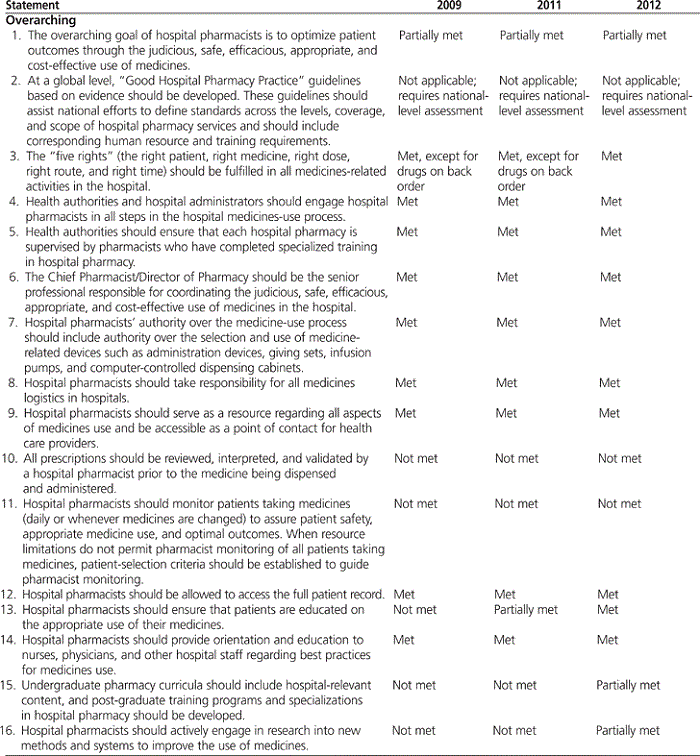
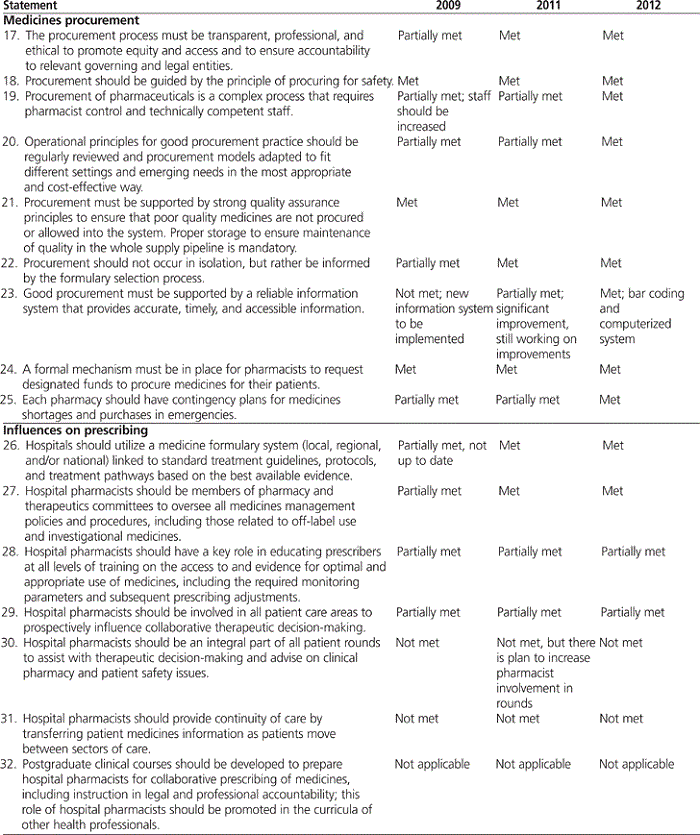
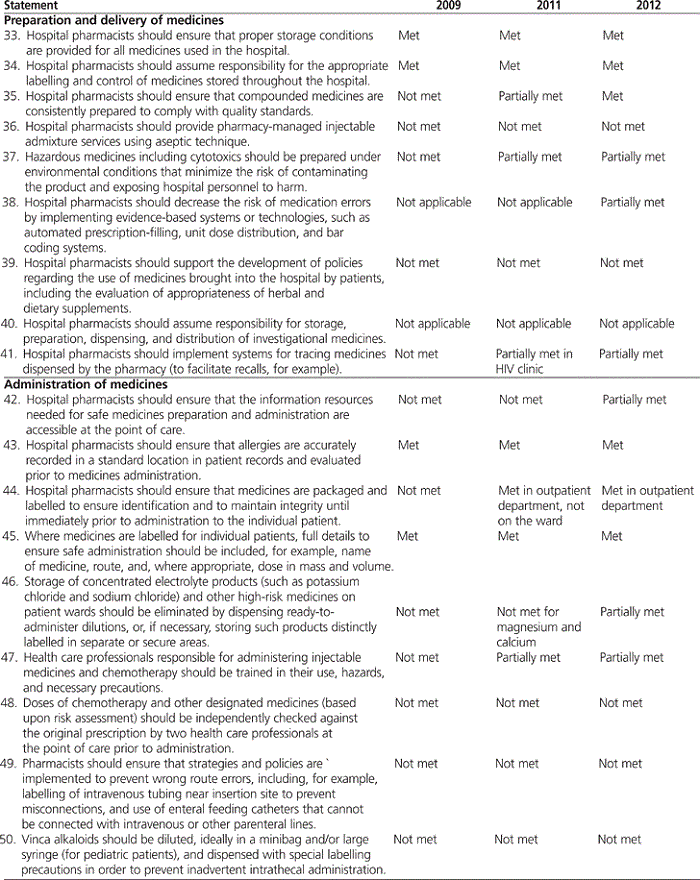
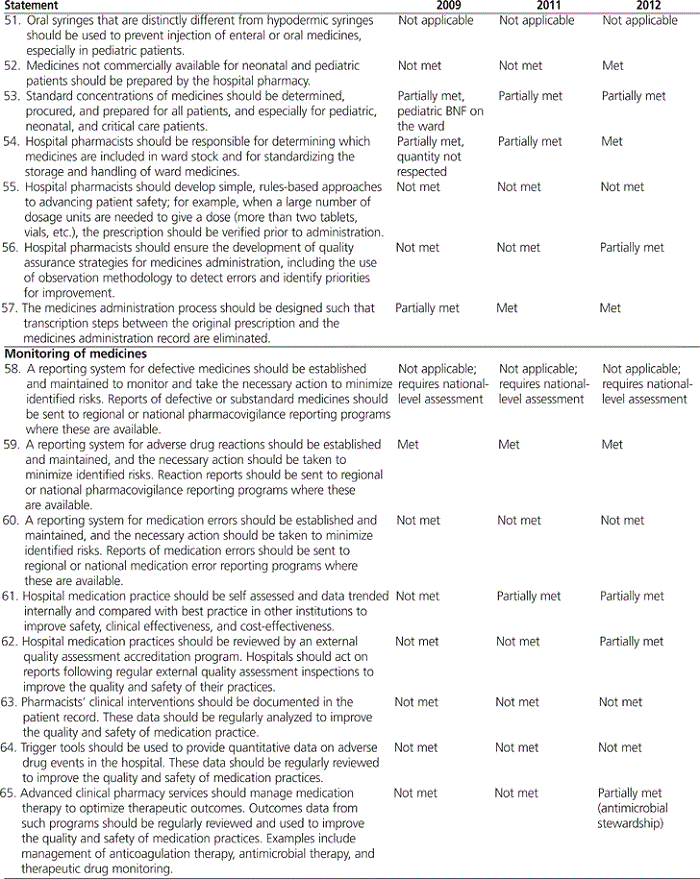
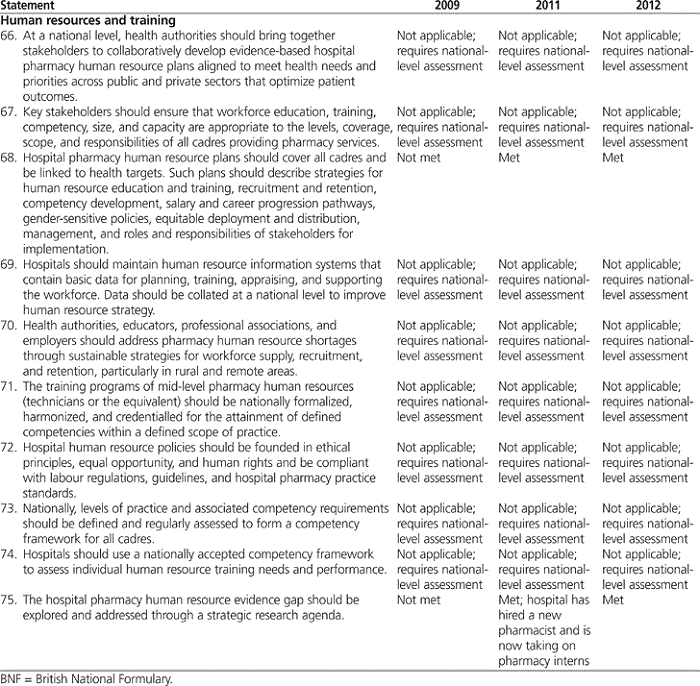
In conjunction with the executive team at St Mary’s Hospital, 24 PSF-Canada recommendations specific to the hospital were developed in 2009 to close the gap between current practice and desired pharmacy practice as described in the Basel consensus statements. These recommendations served as the action plan and guiding document for all PSF-Canada pharmacists and the pharmacy management team to achieve the vision as defined by the consensus statements. These 24 recommendations, along with an additional 5 recommendations developed in 2011, constituted a proposed normative framework for the overall improvement process (Table 3). The recommendations encompassed 6 of the 7 themes set out in the 2008 Basel consensus statements: overarching statements on the future of hospital pharmacy, medication procurement, influences on prescribing, preparation and delivery of medicines, administration of medicines, and monitoring of medication practices. No recommendations were established for the seventh theme, human resources and training, because fulfilling the applicable consensus statements would require a coordinated approach on the part of national governing bodies and/or multiple stakeholders, something that is not feasible for a single hospital or institution.
Table 3.
PSF-Canada Recommendations in Relation to Themes of 2008 Basel Consensus Statements PSF-Canada Recommendation, by Theme
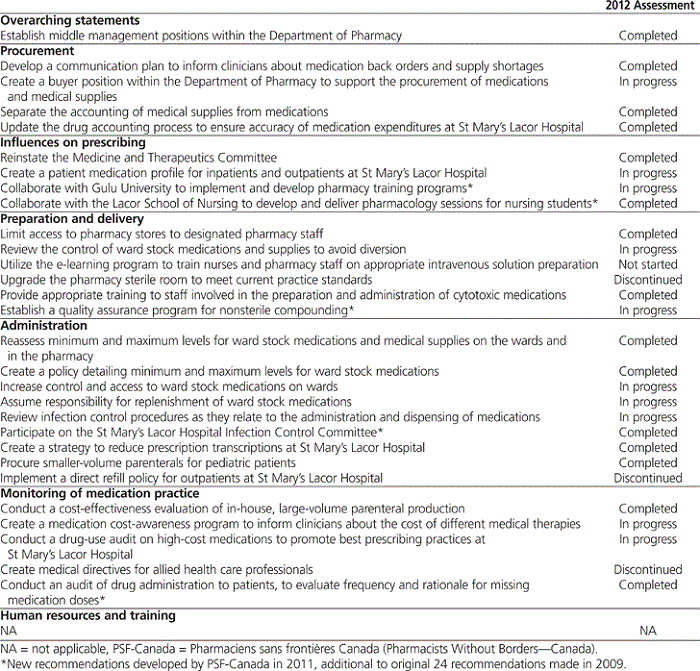
Interventions to fulfill the PSF-Canada recommendations are listed in Table 4, along with their status in 2011 and 2012. These interventions include streamlining ordering and inventory processes for pharmacy supplies, conducting monthly audits to ensure accurate accounting of medication stores and supplies, developing training programs and policies to meet international guidelines and standards, and providing input on the creation of performance indicators for various key quality indicators, such as hand washing, sterilization, and use of disinfectants. Of the 29 PSF-Canada recommendations, 15 were deemed complete at the assessment in June 2012; another 10 were in progress, 1 had not yet been started, and 3 had been discontinued.
Table 4.
Status of PSF-Canada Recommendations (2011 and 2012)
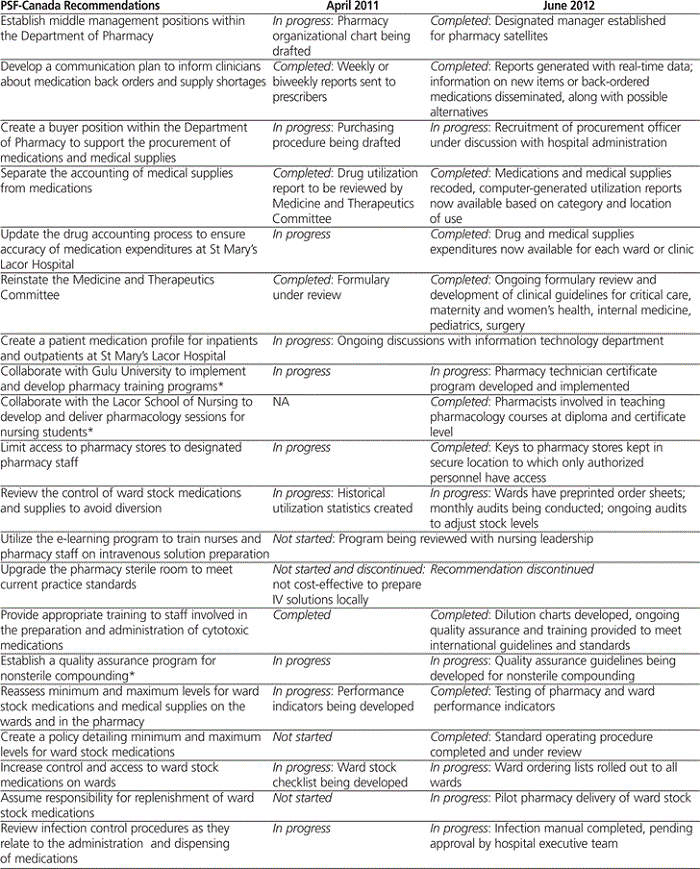
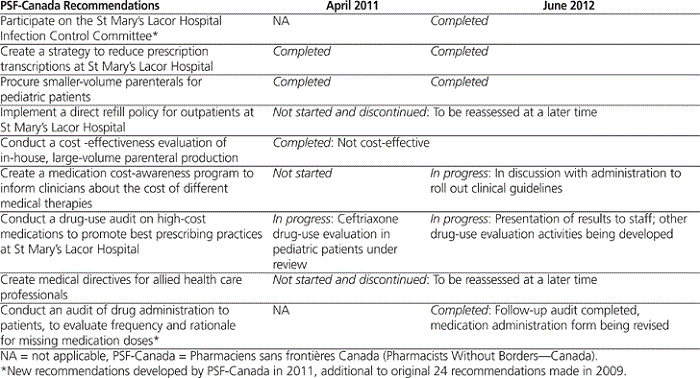
The 2008 Basel consensus statements represent a shared vision of the future of hospital pharmacy, as defined by an international consortium of hospital pharmacists and pharmacy leaders. The selection of these statements as one of the guiding documents used by PSF-Canada to create its recommendations for the Lacor Hospital was deliberate, as they are similar in scope and focus to drug management standards used in the United States4 and Canada.5 For example, the Basel consensus statements parallel the Accreditation Canada Qmentum medication management standards, which detail all aspects of medication management, such as selection, procurement, labelling, storage, preparation, administration, and monitoring of medication use to achieve positive patient outcomes.5 Use of predefined criteria to assess pharmacy services allows observers to objectively and clearly evaluate a hospital’s medication management system, which is particularly important if the survey team does not include a pharmacy expert. More importantly, the Basel consensus statements were chosen because Lacor Hospital is located in a country that has yet to adopt national drug management standards, and these statements provide a systems-based approach to assessing and designing a medication management system. A patient-focused approach (such as that used by Accreditation Canada) is the ideal context in which to gauge a medication management system; however, such an approach assumes (and requires) that an adequate medication supply chain and monitoring system are already in place. This assumption may not be valid in places where the supply chain is strained and under-resourced. In addition, the Basel consensus statements offer a global perspective on assessing a medication management system; for example, terms commonly encountered in the standards of Accreditation Canada or the US Joint Commission may be familiar to health care professionals in Canada and the United States but may not be feasible or applicable elsewhere. The Basel consensus statements translate the ideas of medication management into terms and languages that are relevant and understandable across all cultures and contexts.
The limitations of this study included inability to assess 14 of the criteria in the Basel statements at the hospital level, as they require a coordinated approach by national governing bodies and/or multiple stakeholders. For example, under the seventh theme of the consensus statements, human resources and training, promotion of a national-level strategy to develop evidence-based human resource plans and training were judged by the PSF-Canada pharmacist advisors and the Lacor Hospital executive team to be unattainable within the proposed time frame.
At the time of publication, in late 2013, the assessment of progress at the Lacor Hospital was ongoing. At each assessment point so far, certain consensus statements that had not been fully realized were being actively addressed. As such, there was a need for a category (“partially met”) to accurately reflect the work achieved thus far. Creation of this category permitted interpretation of the outcomes achieved to date, although the interpretation can vary by observer or assessor. In this case study, the assessors were the PSF-Canada pharmacist advisor (R.V.) and the PSF-Canada pharmacist on site. The increase in the number of “partially met” recommendations noted in the 2011 assessment was related to the new PSF-Canada recommendations put forth that year.
To the authors’ knowledge, this is the first descriptive study illustrating the use of the 2008 Basel consensus statements as a normative framework to assess, realign, and monitor pharmacy practice in a tertiary care hospital. Further studies are required to validate the observations described in this article. However, the Basel consensus statements do allow assessment of a hospital’s pharmacy practice against the preferred vision of hospital pharmacy practice and represent a useful tool for realigning and monitoring pharmacy practice in the hospital setting.
The 2008 Basel consensus statements represent a useful framework for assessing, realigning, and monitoring pharmacy practice because they are international in emphasis and are not limited to a particular culture, country, or context. Fourteen statements were deemed not applicable to assessments of pharmacy practice in an individual hospital, as they require national-level assessment. Further studies are required to validate the observations reported here.
1. Annex 8: Joint FIP/WHO guidelines on good pharmacy practice: standards for quality of pharmacy services. In: Forty-fifth report of the WHO Expert Committee on specifications for pharmaceutical preparations. WHO Tech Rep Ser 961. Switzerland (Geneva): World Health Organization; 2011 [cited 2012 Sep 15]. p. 310–23. Available from: http://apps.who.int/medicinedocs/documents/s18676en/s18676en.pdf
2. The Basel statements on the future of hospital pharmacy. Am J Health Syst Pharm . 2009;66(5 Suppl 3):S61–6.
3 2006 FIP global pharmacy workforce and migration report. The Hague (Netherlands): International Pharmaceutical Federation; 2009 [cited 2012 Sep 15]. Available from: http://www.fip.org/programmesandprojects_pharmacyeducationtaskforce_humanresources
4. Medication management [standard]. In: Hospital accreditation standards . Oak Brook (IL): The Joint Commission on Accreditation of Healthcare Organizations; 2008.
5. Managing medications [standards]. Ottawa (ON): Accreditation Canada; 2012 [cited 2012 Sep 15]. Available from: http://www.accreditation.ca/accreditation-programs/qmentum/standards/managing-medications/
The authors thank Gahda Shaka, Lisa Brander, and Doret Cheng for volunteering their time and expertise in serving PSF-Canada as consultant pharmacists for the Lacor Hospital mission. The authors also thank the Teasdale-Corti Foundation and the Marcelle and Jean Coutu Foundation for their support throughout this program. Annie Pouliot revised the manuscript before submission.
Competing interests: Josephine Oyella received travel funding from the Pharmabridge Program. None declared for other authors.
Canadian Journal of Hospital Pharmacy , VOLUME 66 , NUMBER 5 , September-October 2013